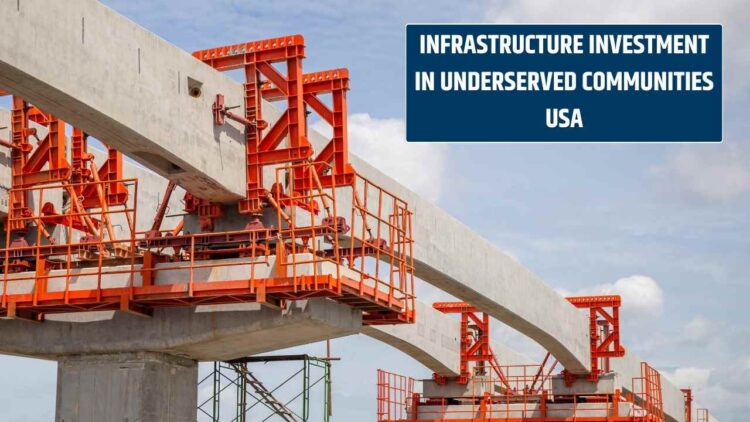The American infrastructure landscape has improved due to the federal investments and initiatives taken over the past few years, especially for the underserved communities. Let’s understand how the infrastructure investment is going for the underserved communities in the USA.
Infrastructure Investment in Underserved Communities USA
The historic Bipartisan Infrastructure Law, or IIJA 2021 Act, initiated the infrastructure investment that has delivered the assistance and funding the infrastructure projects need. The government has started various federal programs and grants administered by various government agencies.
The government has taken the initiative to strengthen rural, tribal, or geographical areas that have less investment in infrastructure, such as transportation, water, energy, and other facilities. According to reports, major funding for the underserved communities was provided through IRA, IIJA, and CHIPS.
The federal government supported the underserved communities’ infrastructure and allocated funds to state and local governments to fund the projects. The CHIPS, IRA, and IIJA have invested around $464 billion to develop the rural areas and establish connectivity.
What are the government initiatives for infrastructure development for the underserved communities?
The federal government has taken various initiatives to fund the infrastructure development in the underserved communities and improve the lives of the citizens. We have listed the initiatives and programs funding the infrastructure development through the Bipartisan Infrastructure Law, IRA, or CHIPS:
- Justice40 initiative:
- The Biden administration has initiated Justice40, where 40% of the federal spending in programs like infrastructure, energy, and others would go to the disadvantaged communities.
- Under this initiative, grants, federal investments, and spending are covered to support disadvantaged communities.
- Reconnecting Communities Pilot Program:
- The government started the RCP program under the IIJA 2021 act to advance community-focused transportation and increase the connectivity between communities.
- The project focuses on enhancing access to daily needs, hospitals, education, food, and other basic services for disadvantaged communities.
- The funding for the reconnecting projects is done in two types of grants: formula and competitive grants.
- Rural Water Infrastructure:
- The USDA has invested around $642 million for clean, reliable drinking water, storm water, and sanitary water disposal for communities in 41 states.
- Rural Action Inc. has received the funding of $122,000 for best waste management practices, recycling, and others to various parts of the USA.
- Energy Infrastructure:
- DOE ensures that communities that are at risk of not receiving the funds get the investment for energy infrastructure.
- The government announced $1.15 billion investment for energy communities, and $900 million for remote and rural communities.
- The DOE’s OECD has already awarded $366 million to 17 projects to ensure a clean energy supply for the underserved communities in 20 states and 30 tribal communities.
- TIFIA Rural Project Initiative:
- The initiative was taken to provide a loan to improve the transportation infrastructure of rural America.
- TIFIA finances the small communities and rural American transportation infrastructure projects between $10 million and $100 million.
What are the issues in infrastructure investment for underserved communities?
The US has 97% of the landmass consisting of rural America, where around 40 million people live, that is, 19 to 20% of the total population. Poverty has increased in the rural areas as more than 100,000 farms have been closed since 2011. Many towns, rural, or tribal communities are struggling to have basic services, such as first responders, libraries, etc.
The federal government must take initiatives to improve the infrastructure for the underserved communities. The major issues that the current infrastructure sector is facing in the underserved communities are:
- Historical and structural infrastructure: Rural areas or disadvantaged communities have decades-old infrastructure or no basic infrastructure due to low funding, which has created a barrier for investment, as large amounts of funding would be needed.
- Funding issues: Most of the projects under the infrastructure development for the underserved communities did not reach the final stage. The public data reveals it happened due to the transition between administrations; for instance, the 2023 report reveals that around 25 projects have been paid for, whereas the $3.1 billion remains unpaid for 78 projects.
- Implementation Issues: The rural areas generally do not have skilled labor, which can delay the infrastructure development, or the federal or state compliance rules can be overwhelming for the communities, which can also delay the infrastructure development.
- Higher cost: The infrastructure development is expensive, and in rural areas, the biggest barrier is the cost of the project and the revenue from the project.
What is the impact of the infrastructure investment on underserved communities?
The infrastructure investment for the underserved communities in the USA has impacted the sector in the following way:
- Job Creation: The infrastructure investment in the underserved communities has created various job opportunities for the people, boosting their purchasing power and ultimately improving the economic growth.
- Energy Access: The energy infrastructure investment ensures that the energy cost is reduced for rural Americans, and they can access the needed energy.
- Basic Services: The low-income households or rural communities can access basic services, such as schools, healthcare, clean drinking water, and others.
- More investment: The IIJA Act funding is distributed geographically, where the lower-income states receive more investment for infrastructure development.
The federal government in the USA has ensured that rural America and underserved communities do not lag in infrastructure development and has initiated a program that will strengthen the infrastructure.



